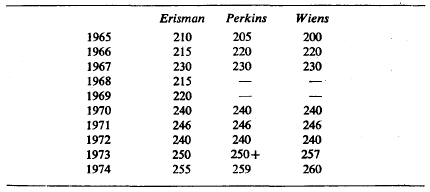Article contents
Chinese Grain Production: An Interpretation of the Data
Published online by Cambridge University Press: 17 February 2009
Extract
By 1975, after a period of widely divergent estimates for Chinese grain production, a consensus appeared to be emerging. Consider, for example, the estimates that were published at the time (in million tons):

Not only was there a consensus, but it was widely assumed that the figures were consistent with those published in the late 1950s. Since then, evidence has been accumulating that the definition of grain has changed and that not all of the figures released in any given year conform to the definition commonly used at the time. We will review the changes in the definition of grain and present our interpretation of the data that have been released in the past 20 years.
- Type
- Research Note
- Information
- Copyright
- Copyright © The China Quarterly 1978
References
1. Alva Lewis, Erisman, “China: agriculture in the 1970s,” in Joint Economic Committee of the U.S. Congress (JEC), China: A Reassessment of the Economy (Washington, D.C.: Government Printing Office, 1975), pp. 328–29;Google ScholarDwight, H. Perkins, “Constraints influencing China's agricultural performance,” in JEC, p. 351; and Thomas, B. Wiens, Agricultural Statistics in the People's Republic of China, prepared for a Conference on Quantitative Measures of China's Economic Output, the Brookings Institution, Washington, D.C., January 1975.Google Scholar
2. State Statistical Bureau, Ten Great Years (Peking), 1960, pp. 119 and 124. We calculated the figures corresponding to the alternative definitions from detailed data on the various types of grain.Google Scholar
3. See, for example, First Five-Year Plan for Development of the National Economy of the People's Republic of China in 1953–57 (Peking), 1956, p. 115, and the annual communiqués of the State Statistical Bureau for the years 1952 through 1955. The 1955 communiqué was released on 14 June 1956.Google Scholar
4. See, for example, State Statistical Bureau, Ten Great Years (Peking), 1960, pp. 119 and 124, and the annual communiqués for the years 1956 through 1959. The 1956 communiqué was released on 1 August 1957.Google Scholar
5. The communiqué for 1959 was released on 21 January 1960.Google Scholar
6. See Table 1.
7. Shantung Province Lai-yang (Hsien) Agricultural School, Hsiao mai (Wheat) (Peking), 1975, p. 1.Google Scholar
8. Neville, Maxwell, “Recent Chinese grain figures,” a comment in The China Quarterly, No. 68 (March 1976), p. 817.Google Scholar
9. Kenneth, R. Walker, Provincial Grain Output in China: 1952–57, Research Notes and Studies, No. 3 (London: Contemporary China Institute, School of Oriental and African Studies, University of London, 1977), p. 2.Google Scholar
10. Audrey, Donnithorne, “Recent economic developments,” a report from China in The China Quarterly, No. 60 (December 1974), p. 772.Google Scholar
11. Hsiang ma-ling-shu t'ui-hua tou-cheng (Strive Against Potato Degeneration) (Peking), 1969.Google Scholar
12. Foreign Broadcast Information Service (FBIS), 25 September 1972, p. B2.Google Scholar
13. Alva Lewis, Erisman, “China: agriculture in the 1970s,” pp. 328–29.Google Scholar
14. Statement of Chou En-lai to Edgar Snow, FBIS, 2 March 1965, p. BBB16.Google Scholar
15. China Reconstructs, April 1965, p. 6.Google Scholar
16. Derived as 194 million tons divided by 0-97754. See the sources for the adjusted estimates in Table 1.Google Scholar
17. Survey of China Mainland Press (SCMP), No. 3609, 4 January 1966, p. 24.Google Scholar
18. FBIS, 6 September 1974, p. A8.Google Scholar
19. FBIS, 10 December 1974, p. E2.Google Scholar
20. FBIS, 26 September 1974, p. E9.Google Scholar
21. Table 3.
22. The series was prepared by John S. Aird of the Foreign Demographic Analysis Division, U.S. Department of Commerce, in March 1978.Google Scholar
23. John, S. Aird, “Recent provincial population figures,” The China Quarterly, No. 73 (March 1978) pp. 1–44.Google Scholar
- 4
- Cited by


